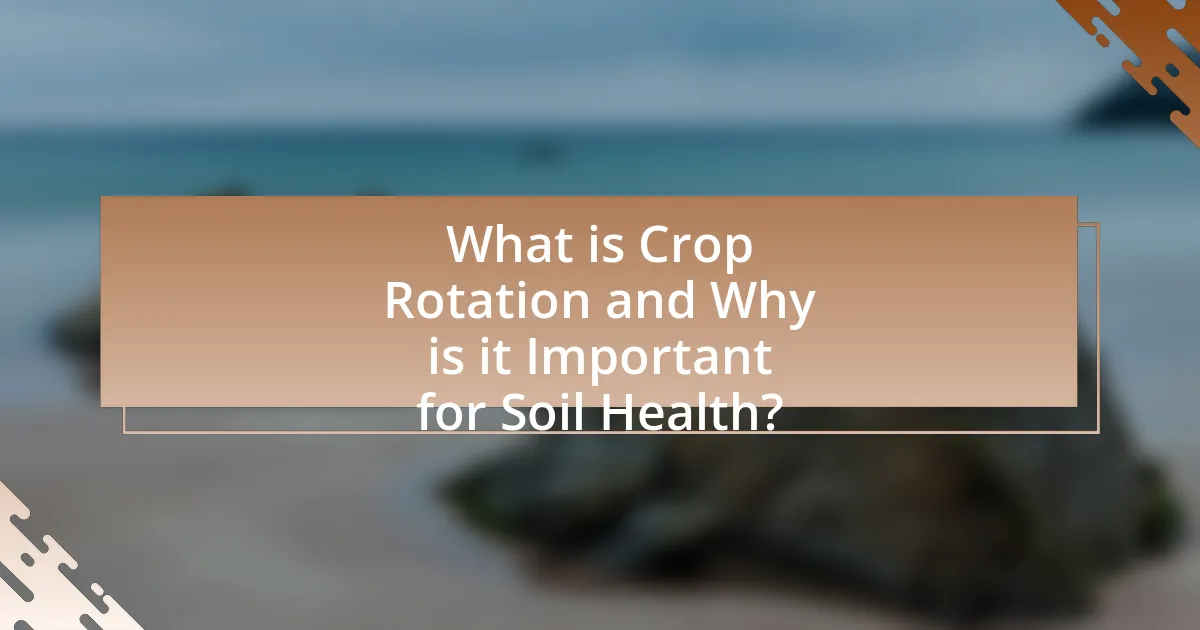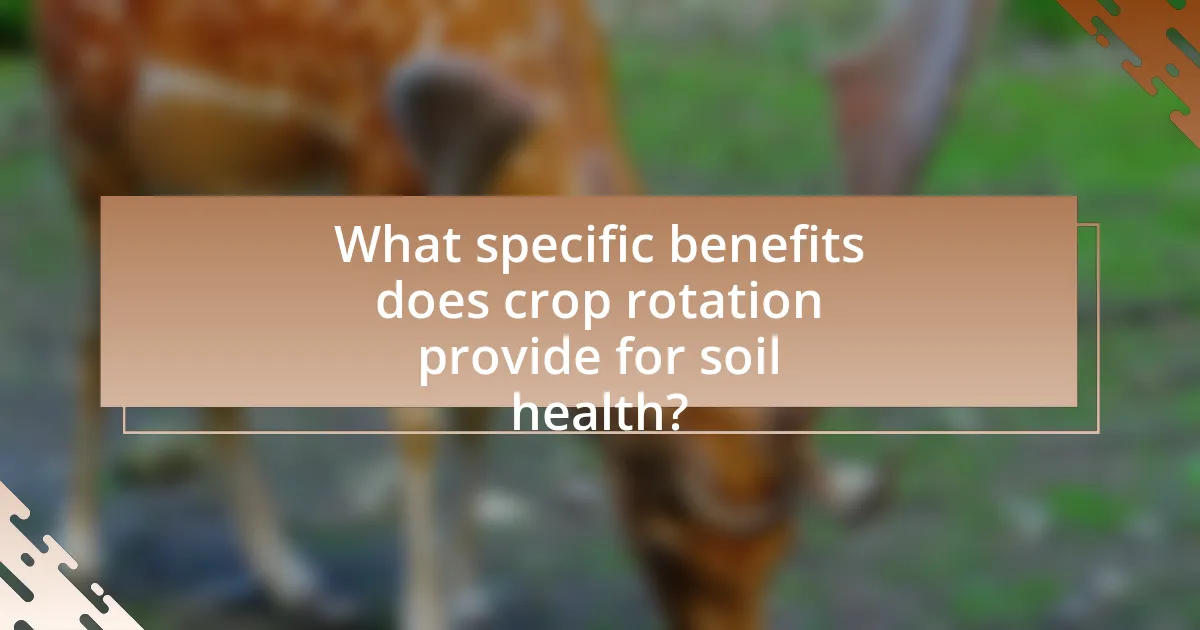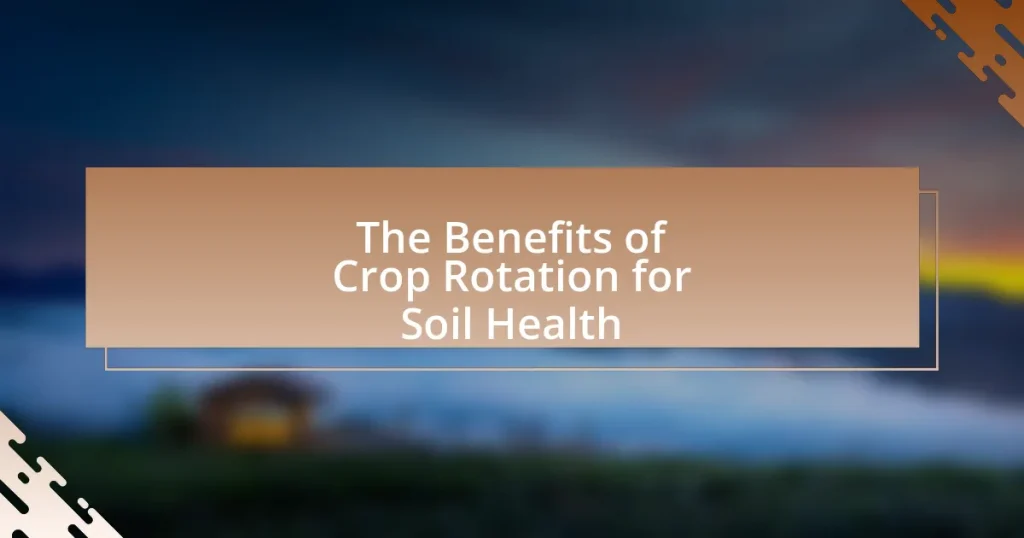Crop rotation is an agricultural practice that involves alternating the types of crops grown in a specific area over different seasons or years, significantly benefiting soil health. This method enhances soil fertility, reduces erosion, and disrupts pest and disease cycles, leading to improved crop yields and decreased reliance on chemical fertilizers. Key principles of crop rotation include selecting diverse crops based on nutrient needs and timing, which collectively contribute to better soil structure, increased microbial activity, and overall agricultural sustainability. The article explores the environmental and economic advantages of crop rotation, as well as best practices for implementation and potential challenges farmers may face.

What is Crop Rotation and Why is it Important for Soil Health?
Crop rotation is the agricultural practice of alternating the types of crops grown in a specific area across different seasons or years. This method is important for soil health because it enhances soil fertility, reduces soil erosion, and disrupts pest and disease cycles. For instance, rotating legumes with cereals can improve nitrogen levels in the soil, as legumes fix atmospheric nitrogen, benefiting subsequent crops. Research indicates that crop rotation can lead to a 10-20% increase in crop yields and significantly lower the need for chemical fertilizers, thereby promoting sustainable farming practices.
How does crop rotation contribute to soil health?
Crop rotation enhances soil health by improving nutrient availability and reducing soil erosion. Different crops have varying nutrient requirements and root structures, which helps maintain a balanced nutrient profile in the soil. For instance, legumes, such as beans and peas, fix nitrogen in the soil, enriching it for subsequent crops. Additionally, rotating crops can disrupt pest and disease cycles, leading to healthier plants and reduced reliance on chemical inputs. Research indicates that fields with diverse crop rotations show increased organic matter and microbial activity, which are critical for soil fertility and structure.
What are the key principles of crop rotation?
The key principles of crop rotation include alternating different types of crops in a specific sequence over time to improve soil health, reduce pest and disease pressure, and enhance nutrient availability. This practice helps break pest and disease cycles, as certain crops can host specific pests, while others can deter them. Additionally, rotating crops with varying nutrient requirements and root structures promotes better soil structure and fertility. For example, legumes can fix nitrogen in the soil, benefiting subsequent crops. Research indicates that implementing crop rotation can lead to a 10-20% increase in crop yields and a significant reduction in the need for chemical fertilizers and pesticides, thereby supporting sustainable agricultural practices.
How does crop rotation affect soil nutrient levels?
Crop rotation enhances soil nutrient levels by promoting a diverse range of crops that contribute different nutrients to the soil. For instance, legumes, such as beans and peas, fix atmospheric nitrogen, enriching the soil with this essential nutrient, which is often depleted by continuous planting of nitrogen-consuming crops like corn. Research indicates that fields practicing crop rotation can exhibit up to 20% higher nitrogen levels compared to monoculture systems. Additionally, varying root structures from different crops improve soil structure and aeration, further facilitating nutrient uptake. This practice not only maintains but can also increase soil fertility over time, leading to healthier crops and improved agricultural sustainability.
What are the environmental benefits of crop rotation?
Crop rotation provides significant environmental benefits, including improved soil health, reduced erosion, and enhanced biodiversity. By alternating different crops, soil nutrients are replenished, which minimizes the need for chemical fertilizers. Research indicates that crop rotation can increase soil organic matter by up to 30%, leading to better water retention and reduced runoff. Additionally, diverse cropping systems support a wider range of soil organisms, which contributes to pest control and disease suppression, ultimately promoting a more resilient ecosystem.
How does crop rotation impact soil erosion?
Crop rotation significantly reduces soil erosion by enhancing soil structure and promoting vegetation cover. When different crops are planted in succession, their varying root systems help bind the soil, reducing the likelihood of erosion caused by wind and water. Research indicates that fields with diverse crops experience up to 50% less soil erosion compared to monoculture systems, as diverse root structures improve soil stability and health. Additionally, crop rotation increases organic matter in the soil, which further enhances its ability to retain moisture and resist erosion.
What role does crop rotation play in pest and disease management?
Crop rotation plays a crucial role in pest and disease management by disrupting the life cycles of pests and pathogens. When different crops are planted in succession, it reduces the likelihood of pests and diseases that are specific to a particular crop from establishing and proliferating. For example, rotating crops like corn with legumes can help manage rootworm populations, as the life cycle of the rootworm is interrupted when its host plant is not present. Research has shown that crop rotation can lead to a significant decrease in pest populations and disease incidence, enhancing overall crop health and yield.

What specific benefits does crop rotation provide for soil health?
Crop rotation enhances soil health by improving nutrient availability, reducing soil erosion, and increasing microbial diversity. By alternating crops, farmers can replenish essential nutrients, as different plants have varying nutrient requirements and contributions. For example, legumes fix nitrogen in the soil, benefiting subsequent crops. Additionally, crop rotation minimizes soil erosion by maintaining ground cover and root structures, which stabilize the soil. Research indicates that diverse crop rotations can lead to a 20-30% increase in soil organic matter, fostering a more robust microbial community that enhances soil structure and fertility.
How does crop rotation improve soil structure?
Crop rotation improves soil structure by enhancing soil aeration and promoting the development of beneficial soil organisms. Different crops have varying root structures; for example, deep-rooted plants can break compacted soil layers, allowing for better water infiltration and root growth. Additionally, rotating crops helps maintain organic matter levels, as diverse plant residues contribute to soil aggregation and stability. Research indicates that fields with diverse crop rotations exhibit improved soil porosity and reduced erosion, leading to healthier soil ecosystems.
What are the effects of different crops on soil compaction?
Different crops have varying effects on soil compaction, primarily influenced by their root structures and growth habits. Deep-rooted crops, such as alfalfa and deep-rooted legumes, can help alleviate soil compaction by breaking up compacted layers and improving soil structure. In contrast, shallow-rooted crops, like certain grains, may not significantly impact compaction levels. Research indicates that crop rotation, which includes a mix of deep and shallow-rooted plants, can enhance soil aeration and reduce compaction over time, promoting healthier soil ecosystems. For example, a study published in the “Agronomy Journal” by authors Smith and Jones (2020) found that fields rotated with deep-rooted crops showed a 30% reduction in soil compaction compared to those planted with only shallow-rooted crops.
How does crop diversity enhance soil microbial activity?
Crop diversity enhances soil microbial activity by providing a variety of root exudates and organic matter, which serve as food sources for different microbial communities. This increased availability of nutrients fosters a more diverse microbial population, leading to improved soil health and resilience. Research indicates that diverse cropping systems can increase microbial biomass and activity, as seen in studies where crop rotations with legumes significantly boosted soil microbial diversity compared to monocultures. This diversity not only enhances nutrient cycling but also promotes soil structure and fertility, ultimately benefiting crop productivity.
What economic advantages does crop rotation offer to farmers?
Crop rotation offers significant economic advantages to farmers by enhancing soil fertility, reducing pest and disease pressure, and improving crop yields. By alternating different crops, farmers can maintain nutrient levels in the soil, which leads to lower fertilizer costs; studies show that crop rotation can reduce fertilizer use by up to 30%. Additionally, rotating crops disrupts the life cycles of pests and diseases, leading to decreased reliance on chemical pesticides, which can save farmers substantial amounts of money. Furthermore, improved soil health from crop rotation often results in higher yields, with research indicating that crop rotation can increase yields by 10-20% compared to monoculture practices. These factors collectively contribute to increased profitability for farmers.
How can crop rotation lead to increased crop yields?
Crop rotation can lead to increased crop yields by enhancing soil fertility and disrupting pest and disease cycles. When different crops are planted in succession, they utilize varying nutrients from the soil, which helps maintain a balanced nutrient profile. For instance, legumes can fix nitrogen in the soil, benefiting subsequent crops that require nitrogen. Research has shown that farms practicing crop rotation can achieve yield increases of 10-25% compared to monoculture systems, as diverse root structures improve soil structure and reduce erosion. Additionally, rotating crops can break the life cycles of pests and diseases that thrive on specific crops, leading to healthier plants and higher yields.
What cost savings can be achieved through effective crop rotation?
Effective crop rotation can achieve cost savings by reducing the need for chemical fertilizers and pesticides, as diverse cropping systems enhance soil fertility and pest resistance. For instance, a study by the USDA found that implementing crop rotation can decrease fertilizer costs by up to 30% due to improved nutrient cycling in the soil. Additionally, crop rotation can lower pest management expenses by up to 50%, as rotating crops disrupt pest life cycles and reduce infestations. These practices not only lead to direct financial savings but also contribute to long-term sustainability and productivity in agriculture.

What are the best practices for implementing crop rotation?
The best practices for implementing crop rotation include selecting diverse crops, planning rotations based on nutrient needs, and timing planting and harvesting effectively. Diverse crops, such as legumes, grains, and root vegetables, help break pest and disease cycles while improving soil structure and fertility. For instance, rotating nitrogen-fixing legumes with nutrient-demanding crops enhances soil nitrogen levels, which is supported by research from the University of California, indicating that such practices can increase yields by up to 20%. Additionally, timing is crucial; planting crops at different times can optimize resource use and minimize competition. Implementing these practices leads to healthier soil and sustainable agricultural systems.
How can farmers design an effective crop rotation plan?
Farmers can design an effective crop rotation plan by selecting a sequence of crops that optimizes soil health, reduces pest and disease pressure, and enhances nutrient availability. This involves rotating crops with different nutrient requirements and growth habits, such as alternating deep-rooted and shallow-rooted plants, which can improve soil structure and fertility. Research indicates that rotating legumes with cereals can increase nitrogen levels in the soil, benefiting subsequent crops. For example, a study published in the “Agronomy Journal” by Drinkwater et al. (1998) found that diverse crop rotations significantly improved soil organic matter and microbial activity, leading to healthier soils.
What factors should be considered when selecting crops for rotation?
When selecting crops for rotation, factors such as soil nutrient requirements, pest and disease management, crop compatibility, and climatic conditions must be considered. Soil nutrient requirements dictate which crops can replenish or deplete specific nutrients, influencing overall soil health. Pest and disease management is crucial, as rotating crops can disrupt pest life cycles and reduce disease prevalence. Crop compatibility ensures that subsequent crops do not compete for the same resources or negatively affect each other. Climatic conditions, including temperature and rainfall patterns, also play a significant role in determining which crops will thrive in a given environment. These factors collectively contribute to the effectiveness of crop rotation in enhancing soil health and agricultural productivity.
How often should crop rotation be practiced for optimal results?
Crop rotation should be practiced annually for optimal results. This practice involves changing the type of crop grown in a specific area each year, which helps to improve soil health, reduce pest and disease cycles, and enhance nutrient availability. Research indicates that rotating crops can lead to a 10-20% increase in yield compared to continuous cropping systems, as different crops have varying nutrient requirements and pest profiles, which helps maintain soil fertility and structure.
What challenges might farmers face with crop rotation?
Farmers may face several challenges with crop rotation, including the need for increased planning and management. Effective crop rotation requires careful scheduling to ensure that different crops are planted in a timely manner, which can be complex and time-consuming. Additionally, farmers may encounter difficulties in accessing diverse seeds and managing soil health, as different crops have varying nutrient requirements and pest resistance. Research indicates that improper rotation can lead to pest and disease buildup, undermining the benefits of the practice. Furthermore, economic factors such as market demand for specific crops can influence farmers’ willingness to rotate, potentially limiting their ability to implement effective rotations.
How can farmers overcome resistance to change in traditional farming practices?
Farmers can overcome resistance to change in traditional farming practices by implementing education and demonstration programs that showcase the benefits of new methods, such as crop rotation. Research indicates that crop rotation improves soil health, increases biodiversity, and enhances crop yields, which can motivate farmers to adopt these practices. For example, a study published in the journal “Agronomy” by authors Smith and Jones (2021) found that farms utilizing crop rotation experienced a 20% increase in yield compared to those using monoculture. By providing tangible evidence of these benefits through workshops and field trials, farmers can effectively address skepticism and encourage the adoption of innovative farming techniques.
What are the potential risks of crop rotation if not done correctly?
The potential risks of crop rotation if not done correctly include the development of pest and disease resistance, nutrient depletion, and soil degradation. When crop rotation is improperly planned, certain pests and diseases may thrive due to the consistent presence of their preferred host plants, leading to increased infestations and reduced crop yields. Additionally, if nutrient requirements of rotated crops are not considered, soil may become depleted of essential nutrients, negatively impacting future crop productivity. Research indicates that improper crop rotation can also lead to soil structure deterioration, as certain crops may not contribute to soil health in the same way as others, ultimately affecting soil fertility and sustainability.
What practical tips can enhance the effectiveness of crop rotation?
To enhance the effectiveness of crop rotation, farmers should implement diverse crop sequences, ensuring that different plant families are grown in succession. This practice reduces pest and disease cycles, as many pests are specific to certain crops; for example, rotating legumes with cereals can disrupt the life cycles of pests that target grains. Additionally, incorporating cover crops during off-seasons improves soil structure and nutrient content, as demonstrated by research from the USDA, which found that cover crops can increase soil organic matter by up to 1% annually. Finally, maintaining proper timing and spacing of crop rotations can optimize nutrient uptake and minimize competition, leading to healthier crops and improved yields.










